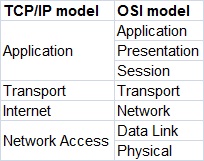OSI & TCP/IP models
OSI model
OSI
(Open Systems Interconnection) model was created by the International
Organization for Standardization (ISO), an international
standard-setting body. It was designed to be a reference model for
describing the functions of a communication system. It has seven layers,
with each layer describing a different function of data traveling
through a network.
Here is the graphical representation of these layers:
The
layers are usually numbered from the last one, meaning that the
Physical layer is consider to be the first layer. It is good to learn
these layers, since there will certainly be a couple of questions on the
CCNA exam regarding them. Most people learn the mnemonic „Please Do Not
Throw Sausage Pizza Away“:
So, what is the purpose of these layers?
They are most commonly used by vendors. They enable them to implement some functionality into a networking device, which then enables easier interoperability with devices from other vendors.
They are most commonly used by vendors. They enable them to implement some functionality into a networking device, which then enables easier interoperability with devices from other vendors.
Here is a brief description of each of these layers.
Physical
– defines how to move bits from one device to another. It details how
cables, connectors and network interface cards are going to work and how
to send and receive bits.
Data Link
– encapsulates a packet in a frame. A frame contains a header and a
trailer that enable devices to communicate. A header, most commonly,
contains a source and a destination MAC address. A trailer contains the
Frame Check Sequence field, which is used to detect transmission errors.
The data link layer has two sublayers:
1. Logical Link Control – used for flow control and error detection
2. Media Access Control – used for hardware addressing and controlling the access method
2. Media Access Control – used for hardware addressing and controlling the access method
Network
– defines device addressing, routing, and path determination. Device
(logical) addressing is used to identify a host on a network (e.g. by
its IP address).
Transport
– segments great chunks of data received from the upper layer
protocols. Establishes and terminates connections between two computers.
Used for flow control and data recovery.
Session – defines how to establish and terminate a session between the two systems.
Presentation – defines data formats. Compression and encryption are defined at this layer.
Application – this layer is the closest to the user. It enables network applications to communicate with other network applications.
The following table shows which protocols reside on which layer:
TCP/IP model
The
TCP/IP model was created in the 1970s by the Defense Advance Research
Project Agency (DARPA). Like the OSI model, it describes general
guidelines for designing and implementing computer protocols.
It consists of four layers: Network Access, Internet, Transport, and Application.
It consists of four layers: Network Access, Internet, Transport, and Application.
The following picture show the comparison between the TCP/IP model and OSI model:
As
you can see, the TCP/IP model has fewer layers than the OSI model. The
Application, Presentation, and Session layers of the OSI model are
merged in only one layer, Application layer, in the TCP/IP model. Also,
Physical and Data Link layers are called Network Access layer in the
TCP/IP model.
Differences between OSI and TCP/IP modelThere are some other differences between these two models, besides the obvious difference in the number of layers. OSI model prescribes the steps needed to transfer data over a network and it is very specific in it, defining which protocol is used at each layer and how. The TCP/IP model is not that specific. It can be said that the OSI model prescribes and TCP/IP model describes.


















No comments:
Post a Comment